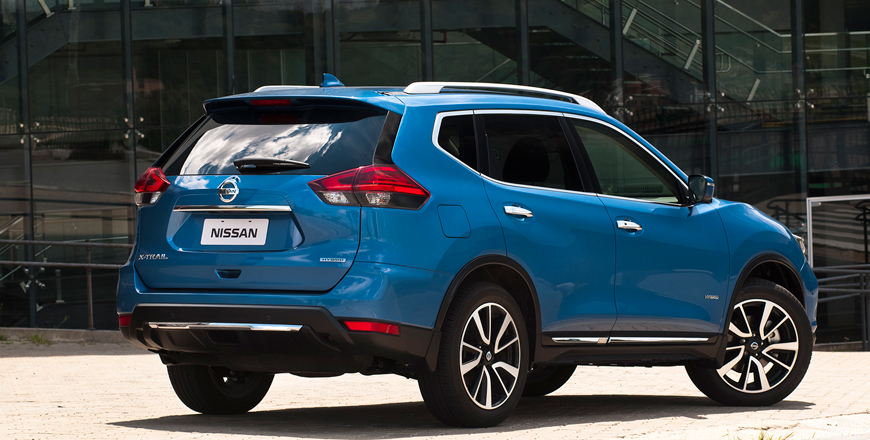First introduced in 2013 and significantly updated with renewed emphasis on improved exterior and interior aesthetics, driving characteristics, refinement, and technology in 2018, the Nissan X-Trail’s recipe of versatility, practicality accessibility is a winning formula that has made it one of the world’s best selling among crossovers and SUVs.
Sold in Jordan in Hybrid guise, the popular X-Trail is a well-equipped and well-appointed yet unpretentious crossover that is user-friendly and reasonably priced, while its hybrid system proved to be discrete and un-intrusive, as it operates in a near seamlessly well-integrated manner.
Swooping style
Virtually indistinguishable from regular combustion engine models and lacking the sometimes pretentiously attention-seeking and virtue signalling design and detail differences associated with hybrid versions of cars, the only thing denoting the X-Trail’s combined petrol and electric drive-line are discrete “Hybrid” badges.
Otherwise, the X-Trail Hybrid features the same swooping bonnet, heavily browed and squinting headlights, curvy waistline and sense of momentum as other versions. Updated in 2018, the X-Trail’s wider, lower and shinier new signature “V-motion” grille and revised lights, sills and bumpers meanwhile lend it a fresher, snoutier and more assertive demeanour.
Negligibly heavier than the petrol-powered 2.5-litre version featured here back in 2018 at the revised model’s launch, the X-Trail Hybrid’s restrained route to electrification trades all-wheel-drive for the addition of an electric motor and battery pack. Comparatively compact, the X-Trail Hybrid’s battery pack sits under the boot, and while it reduces cargo volume slightly, a raised boot floor, however, does allow the X-Trail Hybrid to retain a space saver spare wheel under the floor, unlike some Hybrid competitors with a bulky strap-down spares added as an afterthought for regional markets.

Well integrated
Powered by a naturally-aspirated 2-litre 4-cylinder engine developing 142BHP at 6,000rpm and 147lb/ft torque at 4,400rpm, the X-Trail Hybrid’s smoothly progressive combustion engine is aided by a 40BHP and 118lb/ft electric motor, with which it pairs via a smooth double clutch link for a total 179BHP. With its electric motor serving to boost its low-end response with a significant infusion of torque, the X-Trail Hybrid is flexible in mid-range overtaking manoeuvres and on inclines. Estimated to be capable of 0-100km/h in around 8.8-seconds, the 1,648kg X-Trail Hybrid meanwhile returns moderate 6.7l/100km combined cycle fuel efficiency.
Launching eagerly from standstill with a chirp of tyres and tug of steering owing to the immediacy of torque channelled through the front wheels, the X-Trail Hybrid is driven through a seamlessly smooth and efficient continuously variable transmission (CVT) system. If not as committed or predictably accurate as a traditional gearbox for sportier driving through switchbacks, the X-Trail Hybrid’s CVT nevertheless intuitively matches revs with throttle position and vehicles speed, and minimises the “slingshot” feel typical to many CVT systems. Meanwhile, in “manual” mode one can select pre-set ratios to mimic a traditional gearbox.
Keen cornering
Well-integrating the connection between petrol and electric motors, the X-Trail Hybrid is also notable for quickly recharging its battery pack through braking regeneration and directly from the combustion engine. During extended hill climbs, it coped well in using brief respites between inclines to maintain battery charge, rather than deplete the batteries to the point where the combustion engine struggles in the absence of electric motor input, as is often the case with lesser hybrids. That said, the X-Trail’s chassis proved well able to handle demandingly twisting and sprawling switchbacks with poise.
Tidy on turn-in and with good handling properties and light, quick and accurate steering, the X-Trail Hybrid drives with more eagerness and cornering adjustability than most in its segment, especially with stability control system set to low intervention mode, where automatic braking and weight shifts are more natural, progressive and predictable, than overly cautious in braking the front wheels and shifting weight to the rear. Driven so, the X-Trail Hybrid is keen, chuckable and refreshingly light on its feet through corners, while its agility is aided by a brake-based Active Trace Control torque vectoring system.

Stability and space
Stable and refined on highway and manoeuvrable in town, the X-Trail Hybrid’s somewhat lower profile 225/55R19 tyres might slightly improve handling and appearance, but don’t seem to much affect ride comfort unduly. Slightly firm over some more jagged bumps, it is nevertheless forgiving, fluent and comfortable over most road imperfections, and is settled through dips and crests in vertical travel. With a supportive and comfortable driving position, and decent visibility for its class, the X-Trail Hybrid also features useful 360° and reversing camera to aid visibility, albeit projected through a modest-sized screen.
Refreshed with a more up-market interior since 2018 the X-Trail features improved interior trim, quality, textures, padding, sporty steering wheel, and even faux carbon-fibre door panels. Contemporarily pleasant inside, with good equipment levels, including an intuitive infotainment system, panoramic sunroof, leather seats, automatic tailgate, dual zone climate control, and side and curtain airbags, the X-Trail Hybrid is notably spacious in its segment, with enviable rear leg and headroom. Meanwhile, Hybrid spec precludes optional third row seating and reduces luggage volume slightly from the standard model’s 455-litre minimum, but cargo capacity is nevertheless good, especially with rear seats folded.
TECHNICAL SPECIFICATIONS
Engine: 2-litre, 16-valve, DOHC, transverse 4-cylinders
Bore x stroke: 84 x 90.1mm
Maximum engine speed: 6,400rpm
Hybrid system: Parallel electric motor, 35Kw lithium-ion battery
Gearbox: Continuously variable transmission (CVT), front-wheel-drive
Transmission ratio range: 0.378:1-2.631:1
Power–petrol engine, BHP (PS) [kW]: 142 (144) [106] @6,000rpm
Power – electric motor, BHP (PS) [kW]: 40 (41) [30]
Power, combined, BHP (PS) [kW]: 177 (179) [132]
Torque – petrol engine, lb/ft (Nm): 147.5 (200) @4,400rpm
Torque – electric motor, lb/ft (Nm): 118 (160)
0-100km/h: 8.8-seconds (estimate)
Fuel consumption, combined: 6.7l/100km
Length: 4,690mm
Width: 1,830mm
Height: 1,730mm
Wheelbase: 2,705mm
Headroom, F/R: 1,057/978mm
Legroom, F/R: 1,092/963mm
Shoulder room, F/R: 1,438/1,420mm
Kerb weight: 1,648kg
Suspension, F/R: MacPherson struts/multilink
Steering: Electric-assisted, rack & pinion
Turning circle: 11.3-metres
Brakes, F/R: Ventilated discs/discs
Tyres: 225/55R19
Price, on-the-road: JD31,9003rd (including 3rd party insurance)
Warranty: 5-years or 300,000km